
Welcome to saintpetersburgsnakes.com! I am David, a snake enthusiast living in Saint Petersburg, FL. Many people don't know that Saint Petersburg is in fact full of snakes! You just need to know where to find them - they can often be shy and elusive. Some Florida snake species are more common outside of the city limits, in different parts of Pinellas County FL, but many types of snakes are indeed common in the more urban parts of Saint Petersburg. This guide is meant to help educate you about the beautiful snakes of Saint Petersburg, and to help you identify the most common snakes of Saint Petersburg, as well as the venomous snakes of Saint Petersburg that you should learn to recognize and avoid. If you want more detail, click here for my complete list of ALL snake species in Saint Petersburg. Remember the following:
- Most snakes of Saint Petersburg are harmless and don't want to encounter you
- Venomous snakes exist but are uncommon in Saint Petersburg, Florida
- Snakes eat rats and mice and are a valuable part of the Florida ecosystem
- Never kill a snake - if you leave a snake alone, it will leave you alone.
Common Snake Species in Saint Petersburg
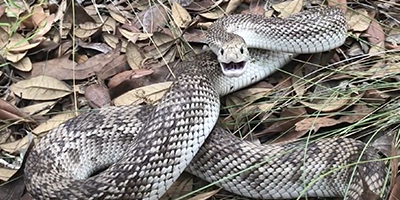 Florida Pine:
(Pituophis melanoleucus)
Florida Pine:
(Pituophis melanoleucus)Appearance:The Florida pine is a long snake species that grows up to 4-8.3 feet long. Body color varies from brown, black, to red with a tail and sharp head.
Habitat:The Florida pine lives in cultivated fields, underground gopher burrows, rocky deserts, prairies, and pine flat woods. It feeds on lizards, small mammals, and gophers.
Behavior:This reptile is a calm animal unless provoked. When attacked, a pine snake lowers its head, vibrates the tail then hisses to intimidate the enemy before fighting back.
 Black Racer:
(Coluber constrictor)
Black Racer:
(Coluber constrictor)Appearance:The black racer is also called the eastern racer. Its body is generally black, while the chin is white. It grows from 24-60 inches long.
Habitat:Black racers may live in residential areas or near water bodies. Diet comprises of rodents and lizards.
Behavior:'Racer and runner' are words that best fit the behavior of this snake species. It's a daylight organism, swift in movement with a clear vision that will fight back with a bite when threatened, though not venomous.
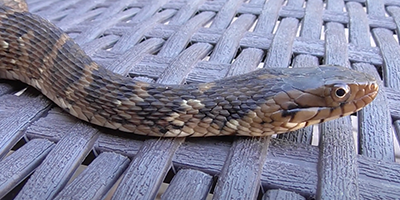 Banded Water Snake:
(Nerodia fasciata)
Banded Water Snake:
(Nerodia fasciata)Appearance:The banded water snake is a medium-sized species that grows up to 24-48 inches long. Body color is either deep-brown or brown-red with square blotches on the belly. A dark band runs from the eye to the jaw.
Habitat:From its name, this reptile lives in water bodies like lakes and marshes. As such, it feeds on water animals, including small fish, frogs, and newts.
Behavior:Banded water snakes are alert all the time: whether at night or during the day. They are ectothermic creatures and will hang on branches near water bodies to forage for food. Also, they lie on rocks and logs basking on sunny days.
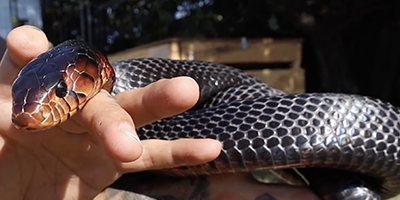 Eastern Indigo Snake:
(Drymarchon couperi)
Eastern Indigo Snake:
(Drymarchon couperi)Appearance: The eastern indigo is among the largest snakes in Florida. It grows to a maximum of 96 inches long. This medium-sized glossy reptile is either dark blue or dark purple with a red or white throat.
Habitat: They live in well-drained soils, dry glades, flat woods, and sand-hill planes. They feedson lizards, birds, frogs, and other snakes.
Behavior: This snake is social as it dens with armadillos and gopher tortoises in their holes. A frightened indigo snake raises its head, vibrates its tail while hissing to scare away its enemy.
Venomous Snake Species in Saint Petersburg
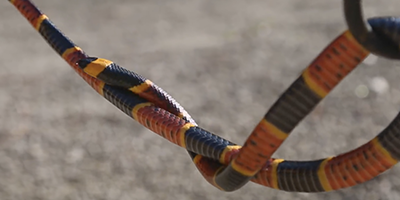 Eastern Coral Snake:
(Micrurus fulvius)
Eastern Coral Snake:
(Micrurus fulvius)Appearance: The thin eastern coral snake is brightly colored so that no one can fail to notice its presence. It is bright red with yellow, red, and black bands. An adult species grows to a maximum of 30 inches long.
Habitat: The coral snake lives in oak sand-hills, hardwood areas, and pine flat-woods. It feeds on small snakes, frogs, and lizards.
Behavior: The eastern coral snake hardly bites unless stepped on or injured. It goes dormant in winter and some parts of the hot summer and emerges when temperatures are favorable.
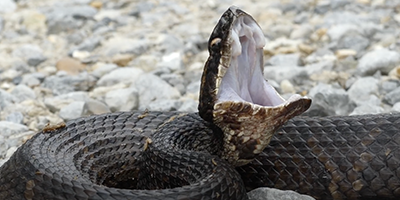 Florida cottonmouth:
(Agkistrodon piscivorus conanti)
Florida cottonmouth:
(Agkistrodon piscivorus conanti)Appearance: The Florida cottonmouth is also known as the water moccasin. It has a white lining in the mouth hence the name "cottonmouth". It's a heavy-bodied, black species with a brown stripe and an average body length measuring 30 to 48 inches.
Habitat: Water is the primary habitat of a water moccasin. However, you may find it in densely-populated urban areas. In terms of nutrition, its diet includes mice, fish, birds, and other snakes.
Behavior: The cottonmouth is an aggressive, nocturnal species that will bite you when provoked. It flattens or coils its body after sensing danger and releases an odor from the anal glands.
If you're unsure, you can email me a photo of the snake at info@saintpetersburgsnakes.com and I will email you back with the snake's species. If you found a snake skin, read my Found a Skin? page, and you can email me a photo of the skin, and I'll identify the snake for you. If you need professional Saint Petersburg snake removal help, click my Get Help page, or see the below website sponsor I found, who provides that service.
Do snakes come out at night?
Although it is not uncommon, it is quite rare to see snakes slithering about during the night. This is more so the case for colder areas, because it isn’t the time of day that dictates when these animals are at their most active — day or night. It is the temperature that determines their behavioral patterns. Snakes are cold-blooded creatures, also known as ectothermic, and this means that they are unable to regulate their own body temperature. When the temperature around them, also known as ambient temperature, is very low, their bodies will struggle to function. The surrounding temperature of the snake will be low, therefore the snake's internal temperature will also be very low too.
When the ambient temperature is high — a nice, balmy night, for example — the snake will be able to absorb the heat from its surroundings. You are very unlikely to see a snake at all when the temperature is low, such as during winter, but during the summer, when the night time can bring temperatures that are just as hot as the day time, the snakes are able to function perfectly fine. It’s the temperature that is important.
Snakes aren't the only animal to be mostly non-nocturnal — coming out during the day. Most reptiles are ectothermic, or cold-blooded, and this means that they will work with their ambient temperature in the same way. The sun's heat is used by the animal, absorbed so that the internal temperature of the body can then be raised.
You MUST NOT assume that a cold night means a safe night, however. There are plenty of cases of various snake species, some venomous, being very active during the night, even hunting very successfully, even in colder climates. In short, if you live in an area with high snake populations, it would be wise NOT to let your guard down.
Remember, the term is not poisonous snakes of Saint Petersburg, it's venomous snakes of Saint Petersburg. Poison is generally something you eat, and venom is injected into you. That said, dangerous snakes are very rare in Saint Petersburg. The few venomous snakes of Pinellas County are rarely seen. But they are commonly misidentified, so learn about all the snake species of Saint Petersburg in order to correctly identify them. These snakes are usually also found in the surrounding towns of St. Petersburg, Pinellas Park, Clearwater, Largo, Palm Harbor, Dunedin, Seminole, Tarpon Springs, Madeira Beach, Oldsmar, St. Pete Beach, Safety Harbor, Treasure Island, Indian Rocks Beach, Gulfport, Belleair, Indian Shores, East Lake, South Pasadena, Redington Beach, Tierra Verde, Redington Shores, Belleair Beach, Kenneth City, Belleair Bluffs, North Redington Beach, Bay Pines, Belleair Shore, Feather Sound, Bardmoor, Harbor Bluffs, Gandy, and the surrounding areas.
Read our article about:
How do snakes communicate?
saintpetersburgsnakes.com domain and hosting costs made possible by the generous support of this sponsor:
